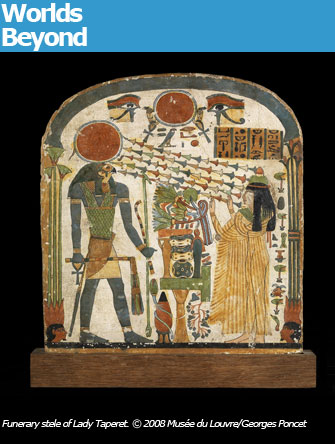
A new exhibition at the Louvre, “Les Portes du Ciel” (“The Gates to Heaven”), takes visitors through those gates into the next world as imagined by the Egyptians, illustrated by a wealth of stunning …

A new exhibition at the Louvre, “Les Portes du Ciel” (“The Gates to Heaven”), takes visitors through those gates into the next world as imagined by the Egyptians, illustrated by a wealth of stunning objects, a large percentage of them from the Louvre’s own collection.
The riches of ancient Egypt may seem very familiar, but it is an endlessly fascinating subject. And then there is the sheer pleasure of examining and appreciating the extraordinary skills of artists and craftsmen working many millennia ago: the gracefully carved lines incised in stone that so economically capture the curve of a leg, for example, or the vivid, beautifully preserved colors and designs painted on lightweight yet rigid mummy cases made of layers of fabric dipped in plaster.
And, of course, you’ll find the obligatory mummy, because any exhibition about ancient Egypt is necessarily about death or, more properly, life after death. The texts (some, but not all, in English) accompanying the wide variety of objects on show are well worth reading.
Some of them tell stories about the gods, as exciting and scandalous as those of the Greek gods. Take the story of Seth, who not only killed his brother Osiris but also decapitated him, mutilated his body and threw it into the Nile. As if that weren’t enough, he then profaned the body, chopped it up and distributed the pieces in different countries. Isis, Osiris’s wife and sister, searched out the pieces of her husband’s body and had them put back together by jackal-headed god Anubis (who happened to be the son of Osiris and Isis’s twin sister, Nephthys). Et voilà – the first mummy was born. No surprise that Osiris is the king of the underworld. That wasn’t enough for Isis, however. She then managed to have a baby, Horus, by the reconstituted Osiris. Each pharaoh (with the exception of the heretical Akhenaten, who worshiped only one god, Aten) was considered to be an incarnation of Horus.
In addition to describing the exciting lives of the gods and illustrating them with handsome works, arranged by theme rather than chronology, this educational show based on the latest research on Egyptology, also offers lessons on Egyptian religious beliefs. We learn why the Egyptians mummified their dead: they believed that each human contained vital forces called ba and ka, which had to be preserved after the person’s death, along with his or her name. The mummy was a sort of tabernacle for these forces, which constituted the individual’s everlasting identity.
Just a few of the more notable pieces (there are over three hundred) in the show: a gorgeously modeled limestone sculpture of a cow’s head from Luxor dating from the New Kingdom, representing a goddess who takes the form of a cow to greet those who have left the earth; hauntingly realistic encaustic Roman mummy portraits from second-or-third-century Egypt; the wooden funerary stele of Lady Taperet, painted on each side with her image, shown praying to different aspects of the sun, with Ra, the sun at its zenith, on one side, and Atum, the setting sun, on the other.
This wide-ranging show, which covers 5,000 years of Egyptian civilization, is beautifully presented, with the first section, on the gods, who made the sun rise and set, painted in sunny yellow, and the second, on death and the underworld, plunged into near darkness.
Musée du Louvre: Hall Napoléon. Métro: Palais-Royal/Musée du Louvre. Tel.: 01 40 20 53 17. Open Wednesday-Monday, 9 a.m.-8 p.m. (until 10 p.m. on Wednesday and Friday). Admission: €11. Through June 29. www.louvre.fr
More reviews of current art exhibitions.
Reader Reaction
Click here to respond to this article (your response may be published on this page and is subject to editing).
